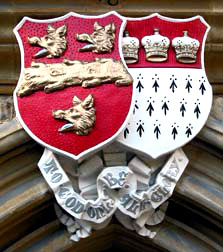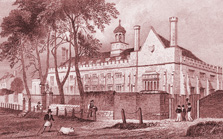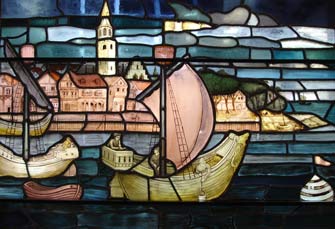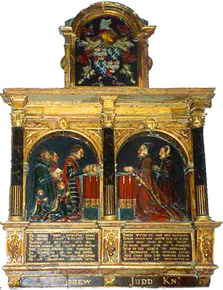Sir Andrew Judde
Six times Master of the Skinners' Company, Mayor of Calais and of London,
Merchant Adventurer and Knight, Sir Andrew Judde was a man who took financial
risks, grew wealthy and founded in Tonbridge one of the foremost public schools in England.

The Judde arms, with boars' heads, and Skinners' Company arms, with
ermine, are displayed above the Porter's Lodge entrance to Tonbridge School.
Judde (also often spelt Judd) was born about 1492, the youngest son of a
significant Tonbridge landowner John Judde, whose lands were mainly to the south
of the Medway, including Barden Park. His elder brothers inherited most of the
estate, so Andrew went to London to seek his fortune. He was apprenticed between
1511 and 1517 to John Buknell, a man involved in both the fur trade, as a member
of the Skinners’ Company, and the wool trade as a merchant of Calais – then a
strategic port in English hands. Kentish wool was exported there and bought by
foreign buyers, so that merchants of the 'staple’, as Judde became in 1517,
benefited from the profits in trade and in currency exchange.
Wool was not the only commodity traded through Calais. Sir Andrew’s name was
also linked to trade in gold dust from Guinea, imports of oil and later also the fur trade
with Russia. In 1533 he became Master of the Worshipful Company of Skinners, an annual post
he was to hold six times. In 1550 he became Lord Mayor of London, when he was
involved in a variety of problems ranging from the high price of larks to cases
of treason. He was knighted by Edward VI at Westminster in the following year.
In his public life Sir Andrew attracted the favour of both Edward VI and
Queen Mary despite the swing from Protestantism to Catholicism, through his
overriding loyalty to the Crown. In spite of being nominally a Protestant, in
Mary’s reign he was active in defending the city from Wyatt’s anti-Catholic
rebellion.

The original building of Judde's 'Grammar School' in Tonbridge, viewed from
the High Street, as it was in 1836. (THS 12.003)
In 1553 there were two exciting developments in the life of Sir Andrew Judde.
The first was that he received a charter from Edward VI to found a school in
Tonbridge. Perhaps wishing to invest some of his wealth for the benefit of the
town in which he grew up, he bought 30 acres of pasture land known as ‘sand
hills’ just to the south of St. Pancras in London. The rents from this land were
to provide funds for the new Tonbridge School, raising the sum of £13: 6s and 8d in 1558. Later, as this land was developed
for housing the rents increased substantially, enabling the Skinners’ Company,
who took over the management of the charity and governorship of the school on
Sir Andrew’s death, to add to the Judde foundation a Workhouse (1720) and three
more schools, including the Judd School in Tonbridge (1888) and Skinners’ School in
Tunbridge Wells (1887).

The original foundation stone of Tonbridge School has been preserved and is now mounted above the Headmaster's Entrance.
At its foundation, Tonbridge School was to be free, boarding and a grammar
school. The last condition meant that the ‘three tongues’ of Latin, Greek and
Hebrew should be taught. Another condition was that the school should be close
to the Parish Church for regular worship and as Sir Andrew did not own land near
enough, it is thought that he rented or bought land from his nephew Henry, who
had just inherited land called ‘Houselands’ close to the centre of Tonbridge. The school opened there in 1553 with just 16 pupils, but now there are a
total of about 3,200 children educated in Skinners’ Company schools.

A window in the Merchant Adventurers' Hall in York
(photo:
flickr (licence))
The second important event in 1553 was the despatch of an expedition by the
Merchant Adventurers Company of London, of which Sir Andrew was a prominent
member. He and others financed the expedition to look for a north east passage
through the Arctic to Asia, and to find new markets for English wool. Two of the
three ships were lost near Lapland, but the third drifted by accident into the
gulf of Archangel and its captain, Richard Chancellor, went on to make the
difficult overland journey to Moscow to meet the tsar, Ivan the Terrible. He had
with him a letter from the King and from that year the trade with Russia began
and the Muscovy Company was created. Richard Judde, Sir Andrew’s son, was with
Chancellor on his second expedition to Russia. On that occasion two of the four
ships were lost which, with the first expedition, amounts to a less than fifty
per cent rate of success. It was a risky enterprise but expeditions continued to
be financed by the Company in which Sir Andrew played a leading role, and before
long strict rules were drafted to improve safety and therefore the success of
the expeditions. One expedition, to Guinea, brought back a rare trophy, the head
of an elephant, which Sir Andrew kept in his house to show to visitors.

The Judde tomb in St.Helen's church, Bishopsgate.
Sir Andrew Judde died in 1558 and was survived by his third wife, Mary, four
sons and two daughters. He is buried in St. Helen’s Church on Bishopsgate in
London, and a memorial there, thought to be commissioned by his heirs in about
1600, describes some aspects of his life. It is not thought to be very accurate
since, because of his public duties, he never visited Russia and Guinea himself,
though he was closely involved in the finance and organisation of expeditions
there. The epitaph reads:
TO RVSSIA AND MVSCOVA / TO SPAYNE GYNNY WITHOVT FABLE / TRAVELD HE BY LAND AND SEA / BOTHE MAYRE OF LONDON AND STAPLE / THE COMMONWELTHE HE NORISHED / SO WORTHELIE IN ALL HIS DAIES / THAT ECH STATE
FULL WELL HIM LOVED / TO HIS PERPETVALL PRAYES
THREE WYVES HE HAD ONE WAS MARY
/ FOWER SUNES ONE MAYDE HAD HE BY HER / ANNYS HAD NONE BY HIM TRVLY / BY DAME
MARY HAD ONE DOWGHTER / THVS IN THE MONTH OF SEPTEMBER / A THOWSANDE FYVE
HVNDRED FYFTEY / AND EYGHT, DIED THIS WORTHIE STAPLAR / WORSHIPYNGE HIS POSTERYTYE
In addition to the Judd School, and Judd House at Tonbridge School, Sir
Andrew’s name is commemorated by Judd Road in Tonbridge and Judd Street on what
is now the Skinners' Company Estate in St. Pancras.
> Copies of An Essay on the Life of
Sir Andrew Judde (1849) by George Maberley Smith and
Sir Andrew Judde (1953) by H. S. Vere
Hodge are in the Local Studies Collection at Tonbridge Reference Library.
> Other sites: Tonbridge
School,
The Skinners' Company
▲Top





